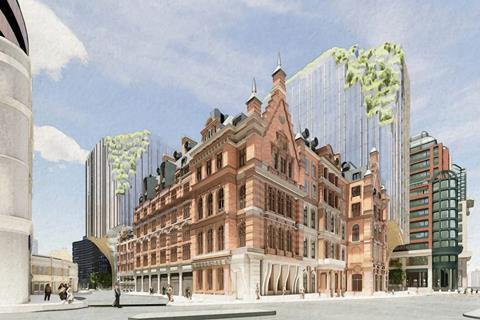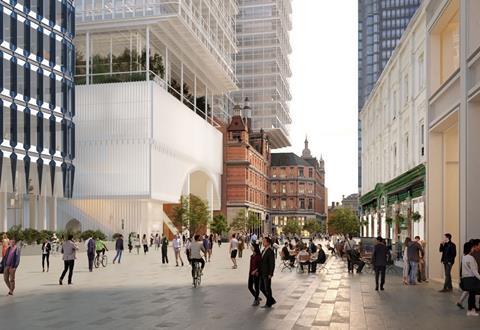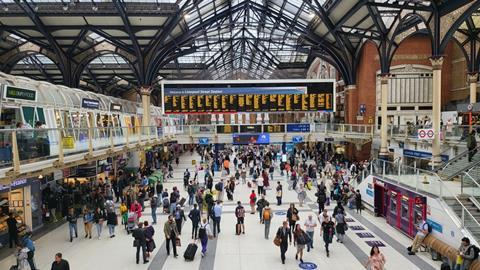Rethink does not “justify concerns” over scrapped Herzog & de Meuron scheme, says Victorian Society-led campaign group
The campaign group which led opposition to Herzog & de Meuron’s now-scrapped plans for the redevelopment of Liverpool Street Station has said it “cannot accept” Network Rail’s new vision for the site.

The Liverpool Street Station Campaign (LSSCA), which is led by Victorian Society president Griff Rhys Jones, said it was “perverse” that the £1bn project was still proposing the demolition of a large section of the station’s concourse roof to make way for a 21-storey office tower.
Network Rail announced it was scrapping Herzog & de Meuron and Sellar’s proposals for the station, the UK’s busiest, earlier this month following strident opposition from heritage campaigners, neighbouring councils and members of the public.
The transport operator unveiled a drastically different vision for the grade II-listed site by new lead architect Acme, replacing the former scheme’s contemporary design with a more Victorian-inspired scheme aiming to preserve the character of the existing station and its adjacent grade II*-listed former Great Eastern Hotel.
The LSSCA has now said the new scheme “does not justify the concerns” of the more than 2,200 people who posted objections to the original planning application and called for Network Rail to rethink the plans.
Rhys Jones said: “It is surely time for Network Rail to stop looking at this handsome station as a development site and to recognise it as the important and historic artefact that it is; one that works and can continue to work.
“Network Rail has a duty for improvements to be less intrusive, and to serve the passenger, not profit. Above all, they should not be seeking huge additions and causing damage to listed buildings as a means to achieve new services.”
The LSSCA pointed to other major Victorian station redevelopments including John McAslan & Partners’ extension to King’s Cross station for an example of how a listed heritage asset could be adapted for the 21st century while “revealing their original Railway Age splendour”.
Acme’s plans would not involve any demolition of the station’s Victorian-era concourse, instead removing large sections of an unlisted 1980s extension which was built in the same style, and would involve no works to the former Great Eastern Hotel.

But the campaign group said the extension had been carried out with “great care and sympathy” and has a “value of its own”, while rendering the neighbouring hotel as a highly significant heritage asset.
The group also criticised the impact of the proposed overstation tower on daylight in the concourse, which it said would become an “oppressive space” hemmed in under a new solid roof replacing the current transparent glass roof.
“This will be more like Cannon Street station than the bright space the visualisations depict,” the group said, adding that the combination of demolition and new development would have a “profound and harmful” impact on the station, the hotel and the Bishopsgate Conservation Area.
The LSSCA is chaired by the Victorian Society with its committee including SAVE Britain’s Heritage, The Twentieth Century Society, Historic Buildings & Places, The Council for British Archaeology, the Georgian Group, the Spitalfields Trust, Civic Voice, London Historians, the Betjeman Society, London & Middlesex Archaeological Society and original campaigners from the 1970s who prevented all the station buildings being demolished.
Acme has been approached for comment.
Network Rail’s response
The need for change at London Liverpool Street station
Liverpool Street remains Britain’s busiest station. Figures released last week show that passenger numbers have risen sharply to 94 million in the last 12 months and that’s just National Rail services. This is set to rise to 140 million per year over the coming decades. We must plan for this.
The current station needs significant improvement. It’s not easily accessible, there is no step-free access and the concourse is not large enough to cope with the rising passenger numbers.

We’re disappointed that following our meetings with the Victorian Society, they don’t currently appear to recognise the substantial beneficial changes that we have made to the design. We would encourage them to continue their dialogue with us.
We listened to concerns from the previous application; we’ve reduced the height of the structure, and our plans no longer interfere with the grade II* listed former Great Eastern Hotel.
The new scheme preserves every part of the listed Victorian station and is reinstating important lost views across the trainshed from the concourse. The new concourse roof will be in harmony with the Victorian architecture.
This redevelopment is about ensuring that our well-loved station remains fit for future generations and reliably accessible for all. And the new office building is the way of funding these station improvements.
Our stations are not artefacts. We want to invest in them, for them to be used and enjoyed by all. They’re working buildings, responsible for transporting over 700m people each year for work, to visit family and friends and to travel.




























No comments yet